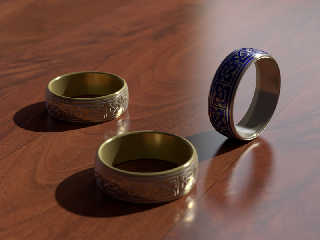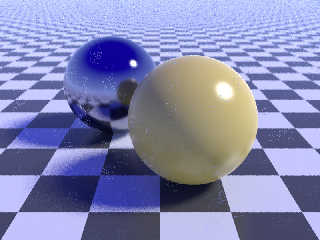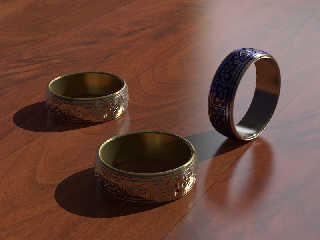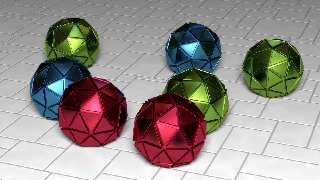 |
 |
|
 |
|
 |
|  |
|  |
|
 |
|
 |
|  |
|  |
|
 |
Nothing serious, just throw some stuff together this morning - to make
it render really slow: isosurfaces, area lights, focal blur, radiosity,
photons and most important (this was the whole point) blurred
reflections for all used materials.
Given that - the render time of about 5 hours was not so bad after all.
And I do love the ease of use for blurred reflections. It gives without
any trial and error the expected results but really high settings for
AA/focal blur are necessary.
What not (yet) seems to work is AA method 3 (see second image). Those
block artifacts (that do resemble the render blocks) do not even go
completely away with extreme settings.
-Ive
Post a reply to this message
Attachments:
Download 'isorings.jpg' (124 KB)
Download 'stochastic_reflection_blur.jpg' (199 KB)
Preview of image 'isorings.jpg'

Preview of image 'stochastic_reflection_blur.jpg'

|
 |
|  |
|  |
|
 |
|
 |
|  |
|  |
|
 |
Am 20.11.2013 13:47, schrieb Ive:
> Nothing serious, just throw some stuff together this morning - to make
> it render really slow: isosurfaces, area lights, focal blur, radiosity,
> photons and most important (this was the whole point) blurred
> reflections for all used materials.
Loooooove it!
I think the gold should use less diffuse though - it somehow kills the
metallic feel. (Rule of thumb: Never, ever, use diffuse on metals. At
least not as long as you have blurred reflections at your disposal.)
> What not (yet) seems to work is AA method 3 (see second image). Those
> block artifacts (that do resemble the render blocks) do not even go
> completely away with extreme settings.
Drat. I remember those artifacts - I thought I had eliminated them a
long, long time ago.
Thanks for reminding me what that change does that hadn't made it from
my dev environment into Perforce yet before I stalled development on
UberPOV for the last few months... >_<
Submitted them to Git right now. You mind trying again?
Post a reply to this message
|
 |
|  |
|  |
|
 |
|
 |
|  |
|  |
|
 |
Am 20.11.2013 16:03, schrieb clipka:
> Submitted them to Git right now. You mind trying again?
Yep. No photons, no area light, no focal blur but +am3 and a render time
of 35 minutes. Not bad, not bad at all. Especially as former experiments
(with large scaled normals for blurring) and scenes where multiple
internal reflections occur have shown sky-rocked render times from 30
minutes to easily 30 hours.
And some notorious difficult parts (like the highlights at the edge of
the rings) are also done quite well.
-Ive
Post a reply to this message
Attachments:
Download 'isorings_am3.jpg' (165 KB)
Preview of image 'isorings_am3.jpg'

|
 |
|  |
|  |
|
 |
|
 |
|  |
|  |
|
 |
Am 20.11.2013 19:04, schrieb Ive:
> Am 20.11.2013 16:03, schrieb clipka:
>> Submitted them to Git right now. You mind trying again?
>
> Yep. No photons, no area light, no focal blur but +am3 and a render time
> of 35 minutes. Not bad, not bad at all. Especially as former experiments
> (with large scaled normals for blurring) and scenes where multiple
> internal reflections occur have shown sky-rocked render times from 30
> minutes to easily 30 hours.
Now for the interesting part: How's the render time with area lights
enabled? (May I presume that you're currently running such a render?)
> And some notorious difficult parts (like the highlights at the edge of
> the rings) are also done quite well.
Yup; I do like what +am3 can do. Avoiding moiree patterns on small-scale
repetitive structures (say checker patterns) is another thing it excels
at, provided you allow it some render time.
And I do like seeing blurred reflections at work. Somehow they add
tremendously to the credibility of an image.
Say, is that wood a procedural texture or an image map?
Post a reply to this message
|
 |
|  |
|  |
|
 |
|
 |
|  |
|  |
|
 |
Am 20.11.2013 19:44, schrieb clipka:
> Now for the interesting part: How's the render time with area lights
> enabled? (May I presume that you're currently running such a render?)
>
Um, sorry, no. I'm currently playing with something else.
But as you command sir, this is going to happen before I go to bed so my
machine gets not rusty overnight ;)
> Say, is that wood a procedural texture or an image map?
>
As the scene is basically just recycled from an example for my spectral
render system it is kinda neither. It is a black/white image used as
pigment_pattern for a color_map.
-Ive
Post a reply to this message
|
 |
|  |
|  |
|
 |
|
 |
|  |
|  |
|
 |
Am 20.11.2013 19:44, schrieb clipka:
> May I presume that you're currently running such a render?
>
Here it is! Did switch projects again as the other one seems to really
need an "overnighter".
Added also area_illumination (even if it doesn't make any sense here,
just to slow things down and maybe discover some bugs) and tweaked the
surrounding a bit to squeeze out a little more contrast.
Used AA settings are +am3 +a0.01 +ac0.995 +r6
Render time *only* 1 hour 1 minute (and the machine was used to watch
some YouTube videos of my actual favorite band). Again, not bad after all.
Not using focal blur gives this image just the right spin for getting
closer to some hyper-realism (something I'm occasionally after) as
especially together with this smooth blurred reflection it is just too
clean and perfect to be real ;)
-Ive
Post a reply to this message
Attachments:
Download 'isorings.jpg' (368 KB)
Preview of image 'isorings.jpg'

|
 |
|  |
|  |
|
 |
|
 |
|  |
|  |
|
 |
Something else: "Wheels At The Waterfront" - the 72' Challenger R/T
tires and rims, modeled over a year ago.
This brand new image shows them exactly as wanted them (based on some
reference images) but back then I did simply give up because both
methods for blurred reflections (large scaled and micro-normals) did
literally last *forever* to render (I know, this is not true, but this
is how I call it when I look at the rendered pixel count and do so again
12 hours later and the number still reads exactly the same).
This was obviously caused by multiple internal reflections inside the
rims and the bad scaling of the blurred reflection methods available for
POV-Ray.
BTW lowering max trace level was/is not an option as the Challenger with
all its fancy chrome, varnish and glass shows otherwise black parts.
I did use, for this image, quite insane and unnecessary high quality
settings for radiosity and area lights just to check the boundaries and
to get a feeling for the quality/time trade-off. Ah, yes, render time
was 3h and 39 minutes.
And yes, I know, the pneus do not look very convincing but I remember
that, a year ago, I did struggle for 2 days with Blender to get them
this far and at the moment I'm not in the mood for that fight again.
So both, blurred reflections and AM3 are IMO a really huge and important
step forward and the adaptive multi-level supersampling does look really
promising given that I actually did fear much longer render times.
And sorry Christoph, no testing from my side on the glare desaturation
as I always render to OpenEXR and prefer my own tool-set for tonemapping
to LDR.
-Ive
Post a reply to this message
Attachments:
Download 'wheels.jpg' (249 KB)
Preview of image 'wheels.jpg'

|
 |
|  |
|  |
|
 |
|
 |
|  |
|  |
|
 |
Am 21.11.2013 08:53, schrieb Ive:
> This brand new image shows them exactly as wanted them (based on some
> reference images) but back then I did simply give up because both
> methods for blurred reflections (large scaled and micro-normals) did
> literally last *forever* to render (I know, this is not true, but this
> is how I call it when I look at the rendered pixel count and do so again
> 12 hours later and the number still reads exactly the same).
...
> I did use, for this image, quite insane and unnecessary high quality
> settings for radiosity and area lights just to check the boundaries and
> to get a feeling for the quality/time trade-off. Ah, yes, render time
> was 3h and 39 minutes.
High Five!
Looks like I'm doing the right thing then.
> So both, blurred reflections and AM3 are IMO a really huge and important
> step forward and the adaptive multi-level supersampling does look really
> promising given that I actually did fear much longer render times.
Thanks, I really love to hear that.
> And sorry Christoph, no testing from my side on the glare desaturation
> as I always render to OpenEXR and prefer my own tool-set for tonemapping
> to LDR.
No problem, the glare desaturation is not the primary focus of UberPOV
anyway. Just one of those small features that suddenly come to mind, are
implemented in a day or so, and need /some/ incarnation of POV-Ray to
live in. Same as the file_time or plaintext reading features.
The stochastic stuff is really /the/ thing I'm hoping to get exhaustive
test feedback on.
Post a reply to this message
|
 |
|  |
|  |
|
 |
|
 |
|  |
|  |
|
 |
On 11/20/2013 07:27 PM, Ive wrote:
> Am 20.11.2013 19:44, schrieb clipka:
> Used AA settings are +am3 +a0.01 +ac0.995 +r6
> Render time *only* 1 hour 1 minute (and the machine was used to watch
> some YouTube videos of my actual favorite band). Again, not bad after all.
After a couple of false starts here's my offering ... I kept getting a
fatal abort until I backed of the aa depth to +4
For the blurred reflection I used roughness 1e-3 maybe too much ...
smaller roughness less blurring?
Post a reply to this message
Attachments:
Download 'work.png' (2667 KB)
Preview of image 'work.png'

|
 |
|  |
|  |
|
 |
|
 |
|  |
|  |
|
 |
Am 25.11.2013 21:07, schrieb James Holsenback:
> For the blurred reflection I used roughness 1e-3 maybe too much ...
> smaller roughness less blurring?
Yes, just as with specular highlights. In fact the two are meant to match.
Post a reply to this message
|
 |
|  |
|  |
|
 |
|
 |
|  |




![]()